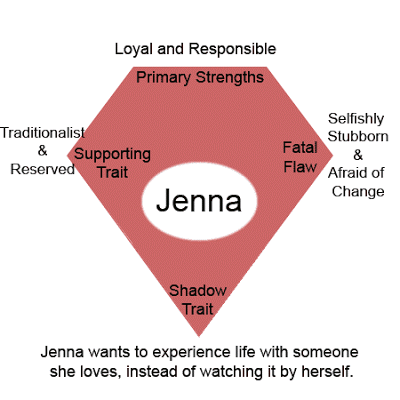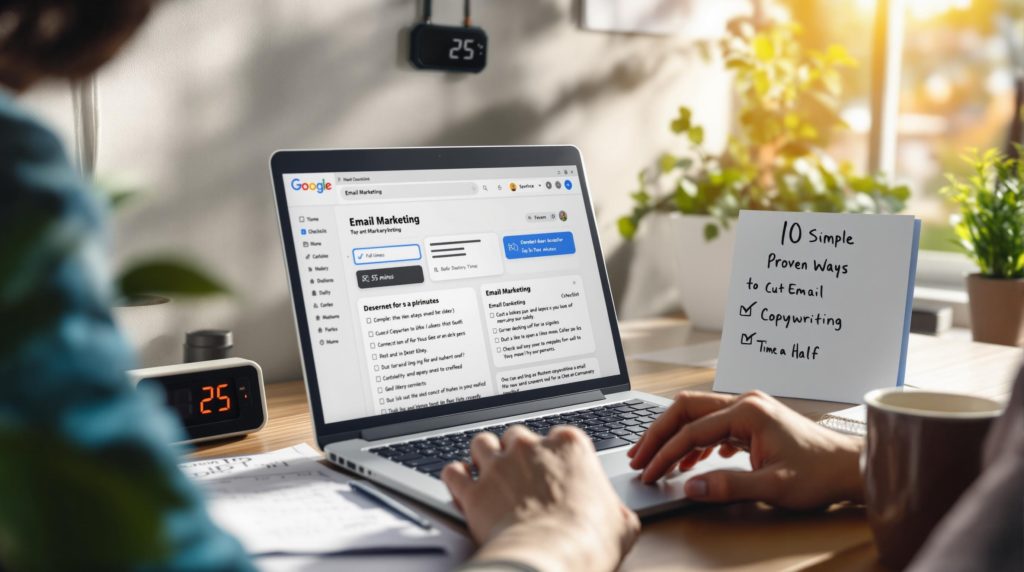OK, so you have no great ambitions to become the world’s most renowned copywriter. In fact, you get hives just thinking about having to sit down and write that needed email sequence. No worries, we have your back.
If somebody has to get that email sequence done and that somebody has to be you, here are 10 ways to help make the whole ordeal go faster. And, maybe even turn out to be a little more fun and profitable.
1. Know your “who”
Put your pen down—no writing yet. We’re going on a hunt for a few critical chunks of data. First and foremost, if you haven’t done this yet—and even if you have, this might be a good time to review—we need to know your prospect as well as you know yourself or your spouse. The best way to do this is with a buyer profile, aka “avatar.” A thoroughly filled out and accurate avatar worksheet gives you a rock-solid foundation from which to start any conversation with your ideal customer. This rings true especially with email because it’s so personal and can be so easily segmented to exactly match their interests. Picture your prospect perfectly and writing emails is a breeze.
2. What does she want “in the moment”?
Accurately tuning into your prospect’s needs in that moment when she opens your email can make all the difference. Using a non-email example to illustrate, let’s say it’s a hot summer day, pushing 95 degrees. You pull into the gas station on your way home from work. You’re thinking, “Dang, it’s hot…How’m I gonna’ chill?” You fantasize, “Gosh, wouldn’t it be sweet to stash a few cold ones in an ice chest and find a shady spot out on the deck… The gas nozzle clicks that your car’s tank is now full. Stashing it back on the pump you check your receipt and, what’s this? It says, “We’ve got ice. Would you like some?” You just got your ice, and the gas station just made a sale. And probably at a pretty good margin, truth be told. See how easy that was? Now you may not always nail it quite like that in your emails. But that’s what we’re shooting for. So before you start churning out that sequence, picture your perfect prospect, what’s she doing when she spots your email? Wishing she had? Hoping to believe? Tuning in just might get you to first base. But first, we need to…
3. Pull out your “battle card”
Just as you wouldn’t show up for battle dressed for a cocktail party, professional salespeople don’t go into a sales conversation without knowing their prospect, competitors, and current market conditions. And, since we’re talking sales and marketing emails here, having a battle card in your pocket will help you zoom in on exactly what needs to be said in each email you write. RELATED ARTICLE:
Email Writing Tips: How to Write Emails that Read Like Buttah
Infusionsoft has put together some great tips for how to write email copy successfully. It…
If you hadn’t heard the term “battle card” before (I hadn’t until recently), you can Google it. Basically, in a sales and marketing context, a battle card gives you nine reference points for any sales conversation, including those pesky emails you’re about to write:
- Market conditions
- Target customers
- Product features
- Competitor analysis
- Customer-specific offers
- Objection handlers
- Golden questions
- Success stories illustrating specific benefits
- Anything else you might need to know
So, before you begin writing, see if you can fill in the data for each of the nine points listed above. You can write them on index cards or store them on your computer. Without this data, you’re just winging it. With it, you’re not only more likely to nail some great opens, clicks, and sales with your emails, and you’ll get ‘em done faster because you can see clearly what needs to be said. Do this in advance, and you’ll be well-prepared to write an effective email.
4. A hack from RPGs
As your business grows, and you establish a brand, you’ll need a consistent “voice” so your audience can easily recognize what’s special about your products or services. Having to rethink that voice each time you sit down to write will not only stress you out and tend to confuse your audience, it just simply slows down the process. A “Character Diamond” is a handy tool from the gaming world for keeping your voice consistent. You may be familiar with it if you’re an RPG (role playing game) fanatic. Here’s an example: 
5. Picture the goalpost
One of the biggest problems inexperienced email writers often have is wandering. It’s tempting to go from point to point, mentioning all the things you want to share with your audience all in one email. I have just a single word of advice for you on that point: Don’t. Emails that tend to get the most clicks and opt-ins or sales stick to one single objective. Are you writing a “Welcome, come on in and make yourself at home!” type of email? Or are you in the middle of a flash sale with a deadline just 48 hours away? It’s critical to pick one objective per email and stick with it. You can always send more emails with different points and objectives later. In fact, that’s the beauty of an email sequence, it gives you the opportunity to stretch your sales presentation out over time so your prospect can mull over each point. This timing aspect can work especially well for narrative or “soap opera” type sequences, where a story develops over time. But each email drives your sales message home, point by point, like a hammer driving a nail. However you stitch your sequence together, keeping a laser focus on one point, one driving emotion, one call to action per email will increase your clicks and opt-ins and sales.
6. Identify your “big idea”
Sometimes you have to take a step outside the forest to see the trees. Finding the one idea that strikes a chord in your prospect can be worth doing a little digging for. Let’s look at some examples:
- “When it absolutely, positively has to get there overnight.” (Fedex)
- “Melts in your mouth, not in your hand.” (M&M’s)
- “Like a good neighbor, State Farm is there.” (State Farm)
No doubt, it takes a little thought to find a single idea that includes a key benefit, differentiates your offer, and evokes positive feelings about it. But, if you’ve done your homework in the previous five tips, you might just stumble across something hot. Keep your eyes open for it. Always take a step back before you start writing, and ask yourself, “What’s the big idea here that I’m trying to convey?” Nailing that will often make it incredibly easy to blast through a single email in practically no time. Even a three-, five-, or seven-part sequence tends to fall in line a whole lot faster when you can see the whole forest. You may not find a killer idea for every email, every time. But seek, and sooner or later, ye shall find!
7. Outline it and you’re half done!
This one tip may be the one that rules them all. Outline your message first, even if just in the back of your mind, and you’ll cut your writing time—and angst—in half. Outlines vary by purpose, but here’s an example of one for when a new prospect has just joined your list or made a purchase:
- Subject: Be clear who it’s from and why
- Warm welcome: First email only if in a sequence
- Early call-to-action: If the next step in your funnel, such as a surprise free gift is compelling enough, you might drop in an offer and CTA right after the greeting. However, leave it out if there’s no way to make it fit in naturally.
- Content: What your prospect can expect over the next X days/weeks/months…
- Call-to-action: Always end with a clear CTA, even if it’s just “Hit reply if you have any questions!” It engages your prospect and, assuming you there’s a clear benefit for responding, it lets them know there’s always a good reason to read your emails
For some emails, a single sentence ending with a question could be all you need. However, it still must contain a few key elements. In that case, a simple list becomes your outline. For example, “Were you still interested in that free pumpkin carving set we’re offering at half off through tomorrow at midnight?” That question contains an implied benefit, urgency, and an implied call to action (reply). There’s your outline. Having that in mind as you begin, and there to check it when you’re done, speeds your writing and helps make it better at generating clicks and sales. Outlining works, whether it’s a one-sentence checklist or framework for an 18-part sales email. Whatever the scope, outline it first and you’ll sail through the writing!
8. Let your inner child have at it first
If you’ve done all the “pre-work” above, you’re primed and ready. It’s time to let ‘er rip! One of the biggest blocks to fast writing is when your inner child and your inner adult can’t come to an agreement on who’s in charge. The moment your child comes up with a new idea, the adult rushes in to list all the reasons it won’t work. No wonder it’s so easy to get stuck staring at a blank screen and blinking cursor. Try letting your inner child and inner adult take turns being in charge. If you typically have an analytical personality you may find this challenging, especially the part about letting the child be in charge. It gets easier with practice, but in the meantime, if you can’t totally release control and just write whatever that comes to mind, at least relax the grip a little and see what comes out. What you may find, especially at first, is what seems like a lot of garbage. It’s OK, just let it flow. You’re not hitting send or publish yet. The adult will have a chance to comb through and discard part or all of it. Odds are, if you’ve done some pre-work, you’ll find a few gems in there before you’re done. It may seem a little woo-woo, but just trust and let it flow. Clayton Makepeace, a renowned direct response copywriter who has sold hundreds of millions of dollars worth of products and services with his writing says once he finishes all the pre-work, often he’ll just sit back, place his fingers on the keyboard, close his eyes, and let it all out. Let your inner child take the wheel and you may be surprised at how quickly the writing happens.
9. Toss the trash; keep the gems
Once you’ve let your inner child make a big creative mess, you’ve at least got something to work with. It gets easier from here. Just prune and tweak. You may find it helpful to edit in several passes. You could start with grammar and spelling. Then logical consistency. Next, check for conversational tone and emotional appeal. Or, you may find it easier, especially in a time crunch, to do them all at once. If you have the time, after editing, sleep on it. Often you’ll come back with a fresh perspective. You’ll see things and get new ideas that hadn’t occurred to you before. Much of the best writing comes after several iterations. RELATED ARTICLE:
7 Ideas for Upgrading Your Call-to-Action
A good call-to-action can change the way your customers interact with your website. Check…
Legendary copywriter John Carlton tells of a sales letter he wrote that went through something like 17 rewrites. Number 18 blew all the others away with sales in the multiples of anything else they’d tried. Sometimes all it takes is tenacity. As the old saying goes, if at first you don’t succeed… Finally, read your email out loud before hitting send or publish. By tweaking based on what you hear yourself saying, your message will almost always come out more clearly. And clarity drives clicks and sales. Editing after your initial writing will keep you from getting stuck. And that can be a HUGE time saver!
10. Rock your subject line
This is the one thing that deserves 90 percent of your time and attention. After the “From” field, the subject line is the most crucial element of your email. After all, if that subject line doesn’t get your email opened, you might as well not even bother with the rest. How do you write a killer subject line without breaking a sweat? Everyone has a different approach. You’ll figure out what works best for you, so keep experimenting. Here are a few ideas to try:
- I’ll often plug in a “working subject line” early, then come back and rewrite it once the rest of the email is done. You not only can match it better to the body of the email that way, often you’ll come up with one or more better ideas.
- “Same old, same old” in the inbox is death. Your email will never get read if the subject line doesn’t somehow stand out to your prospect. And that doesn’t mean you need to shout with all caps or spam it up with hype. Sometimes a simple low key message such as, , did you see this?” is all you need to stand out. Especially when every other subject line is screaming for attention. This is where knowing your prospect intimately helps.
- Use a subject line “swipe file.” You can find these all over the internet. They’re good for when you get stuck or are looking for a new tack. But rarely does it work to swipe one verbatim. What they can help with is sparking an idea or inspiration to try a different approach.
- If you don’t come up with a hit right away, write a lot of subject lines. As Thomas Edison said, “Genius is 1 percent inspiration and 99 percent perspiration.” It doesn’t have to take a lot of time or energy. Sometimes just one word can make all the difference. And it might take a few tries to find that sweet spot that gets a huge response. It might look something like this:
-
- {FirstName}, did you see this?
- {FirstName}, did you see this offer?
- {FirstName}, did you see this offer that ends tonight?
- {FirstName}, this offer ends at midnight…
- Hey {FirstName}, this offer ends at midnight
- When you have one you like, run it through “The 4U’s”: Is it useful, unique, urgent and ultra-specific? It’s rare to find a subject line that scores high on all four U’s, but the higher your total score, the better chance your email will get read.
- And finally, use a tool. You’ll find several on the internet. One I particularly like, even though it’s geared more for blog titles, is the Headline Analyzer by the folks over at CoSchedule.
So there you have it, 10 ways to cut your writing time in half. Follow these tips and your writing will not only go faster, your list and sales will grow. And the more you do, the better it gets. Whether you do all the writing for your business or hire it out, when you implement even just of few of these tips, your email open and click rates will improve. Do all of them consistently, and we’ll watch for you in the Fortune 500.
StrategiCopy.com founder, direct response copywriter and marketing evangelist Mike Connolly has helped grow small businesses in over 40 different industries. An Infusionsoft Certified Partner, Certified Digital Marketer Customer Value Optimization Expert and Dan Kennedy Certified Copywriter for Information Marketers, he forges traffic, conversion, and automation strategies into unified marketing campaigns for growing businesses.On weekends you can find him riding the local bike trails, cruising for veggies at the farmer’s market or sawing out tunes on his fiddle.
![]()
On – By Mike Connolly



